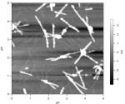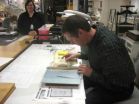(Press-News.org) (Santa Barbara, Calif.) –– UC Santa Barbara scientists have made a discovery that has the potential for use in the early diagnosis and eventual treatment of plaque-related diseases such as Alzheimer's disease and Type 2 diabetes. Their work is published in a recent issue of Nature Chemistry.
The amyloid diseases are characterized by plaque that aggregates into toxic agents that interact with cellular machinery, explained Michael T. Bowers, lead author and professor in the Department of Chemistry and Biochemistry. Other amyloid diseases include Parkinson's disease, Huntington's disease, and atherosclerosis. Amyloid plaques are protein fibrils that, in the case of Alzheimer's disease, develop prior to the appearance of symptoms.
"The systems we use are model systems, but the results are groundbreaking," said Bowers. He explained that his research provides the first examples of the conversion of randomly assembled aggregates of small peptides into ordered beta sheets that comprise fibrils. Fibrils are the final structural state of the aggregation process.
In the article, Bowers describes how understanding the fundamental forces that relate aggregation, shape, and biochemistry of soluble peptide aggregates is central to developing diagnostic and therapeutic strategies for amyloid diseases.
Bowers and his research team used a method called ion-mobility spectrometry-mass spectrometry (IMS-MS). This method enabled the team to deduce the peptide self-assembly method. They then examined a series of amyloid-forming peptides clipped from larger peptides or proteins associated with disease.
Bowers explained that IMS-MS has the potential to open new avenues for investigating the pathogenic mechanisms of amyloid diseases, their early diagnosis and eventual treatment.
The first author of the paper is Christian Blieholder, a Humbolt Postdoctoral Fellow at UCSB. Thomas Wyttenbach, UCSB associate researcher, is a co-author. Nicholas F. Dupuis, who was a Ph.D. student at UCSB at the time of the research, is also a co-author; he is now a postdoctoral fellow at the University of Colorado.
INFORMATION:
UCSB chemists make discovery that may lead to drug treatment possibilities for Alzheimer's
2011-02-14
ELSE PRESS RELEASES FROM THIS DATE:
Pulmonary fibrosis inhibited by pentraxin-2/SAP in research study
2011-02-14
MALVERN, PA – February 10, 2011 – Promedior, Inc., a clinical stage biotechnology company developing novel therapies to treat fibrotic and inflammatory diseases, announced today the publication of collaborative research in the International Journal of Biochemistry and Cell Biology entitled, "TGF-beta driven lung fibrosis is macrophage dependent and blocked by Serum amyloid P." The research showed that human Pentraxin-2 (PTX-2), also called human Serum amyloid P (SAP), potently inhibits all undesirable pro-fibrotic pathologies driven by TGFβ1 and represents a novel ...
Chinks in the brain circuitry make some more vulnerable to anxiety
2011-02-14
Why do some people fret over the most trivial matters while others remain calm in the face of calamity? Researchers at the University of California, Berkeley, have identified two different chinks in our brain circuitry that explain why some of us are more prone to anxiety.
Their findings, published today (Thursday, Feb. 10) in the journal Neuron may pave the way for more targeted treatment of chronic fear and anxiety disorders. Such conditions affect at least 25 million Americans and include panic attacks, social phobias, obsessive-compulsive behavior and post-traumatic ...
Tumor microvesicles reveal detailed genetic information
2011-02-14
The Massachusetts General Hospital (MGH) research team that first discovered tumor-associated RNA in tiny membrane-enclosed sacs released into the bloodstream by cancer cells has now found that these microvesicles also contain segments of tumor DNA, including retrotransposons – also called "jumping genes" – that copy and insert themselves into other areas of the genome. The investigators' report, which has been published in Nature Communications, is the first to show that microvesicles are involved in transferring retrotransposons between cells.
"Retrotransposons' ...
UTHealth, Athersys preclinical research on stem cell therapy for stroke presented at AHA conference
2011-02-14
HOUSTON and LOS ANGELES – February 10th, 2011 – Medical researchers from The University of Texas Health Science Center at Houston (UTHealth) presented new research results at the American Heart Association International Stroke Conference that demonstrated how MultiStem®, a novel stem cell therapy being developed by Athersys, Inc. provided multiple benefits when administered in preclinical models of ischemic stroke. The study, conducted by leading researchers from the Department of Neurology at the UTHealth Medical School working in collaboration with scientists at Athersys, ...
Restructuring natural resource majors
2011-02-14
Madison, WI FEBRUARY 3, 2011 – A troublesome trend is occurring at colleges and universities around the country: fewer students are graduating with degrees in natural resource related degree programs. As a result, the number of qualified professionals to manage fish and wildlife programs is dwindling. What is even more troubling is that nationally, the percentage of students enrolling in the major has increased. For reasons unknown, students have been leaving the natural resource degree path after enrollment to pursue other degrees. Finding cause for the steady decline ...
Study related to diet soda and stroke risk is seriously flawed
2011-02-14
Contact: Stan Samples
ssamples@kellencompany.com
404-252-3663
Calorie Control Council
Study related to diet soda and stroke risk is seriously flawed
Study is drawing a growing body of criticism and skepticism from experts in the field of nutrition and science
The Calorie Control Council stated today that research findings presented during a poster session at the International Stroke Conference claiming an association between diet soft drink consumption and increased risk of stroke and heart attack are critically flawed.
"The findings are so speculative and preliminary ...
Sandia security experts help Kazakhstan safely transport, store Soviet-era bomb materials
2011-02-14
ALBUQUERQUE, N.M. — A Sandia National Laboratories team helped reach a major milestone in the nation's nuclear nonproliferation efforts by working with the Central Asian country of Kazakhstan to move nuclear materials — enough to build an estimated 775 nuclear weapons — to safety.
Sandia provided security and logistics expertise to complete the transfer across Kazakhstan of spent fuel containing 11 tons (10 metric tons) of highly enriched uranium and 3.3 tons (3 metric tons) of weapons-grade plutonium that had been stored in a BN-350 fast-breeder reactor in the busy Caspian ...
Wayne State study: Enhance romance by going out with other couples
2011-02-14
DETROIT— Romantic relationships often start out as enjoyable or even exciting, but sometimes may become routine and boring. A Wayne State University study reveals that dating couples that integrate other couples into their social lives are more likely to have happy and satisfying romantic relationships.
Richard B. Slatcher, Ph.D., assistant professor of psychology in WSU's College of Liberal Arts and Sciences and a resident of Birmingham, Mich., specializes in social and health psychology. His recent research suggests that spending quality time with other couples may ...
VCU Massey first to combine targeted agents to kill multiple myeloma cells
2011-02-14
Richmond, Va. (Feb. 10, 2011) – Scientists at Virginia Commonwealth University Massey Cancer Center have developed a novel treatment strategy for multiple myeloma that pairs two targeted agents to kill cancer cells. The study's findings, published in today's edition of the journal "Blood," are the first to demonstrate the synergistic, anti-myeloma effects of this combination regimen both in vitro and in vivo.
Multiple myeloma is a cancer involving antibody-producing cells in the bone marrow, and, in most cases, is incurable. Targeted therapies work by interfering with ...
University of Arizona experts determine age of book 'nobody can read'
2011-02-14
University of Arizona researchers have cracked one of the puzzles surrounding what has been called "the world's most mysterious manuscript" – the Voynich manuscript, a book filled with drawings and writings nobody has been able to make sense of to this day.
Using radiocarbon dating, a team led by Greg Hodgins in the UA's department of physics has found the manuscript's parchment pages date back to the early 15th century, making the book a century older than scholars had previously thought.
This tome makes the "DaVinci Code" look downright lackluster: Rows of text ...


